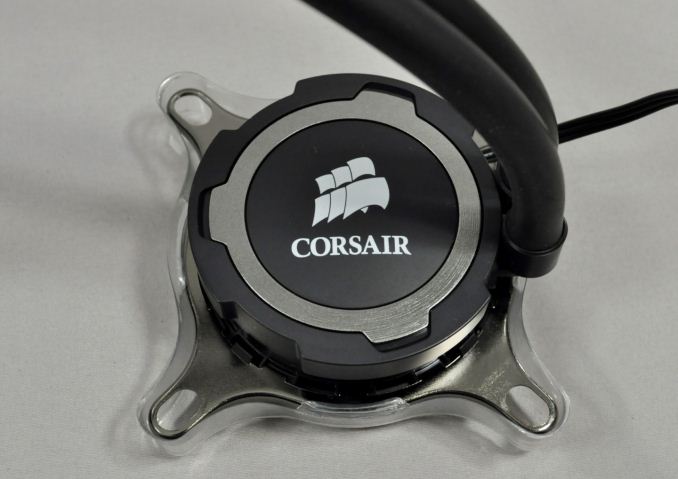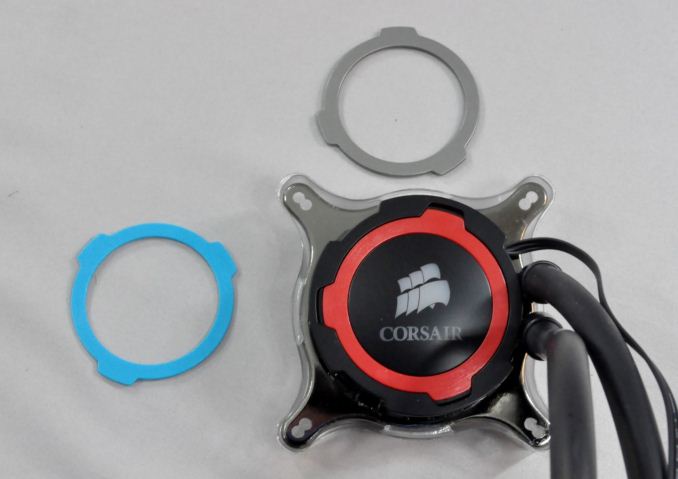Closed Loop AIO Liquid Coolers: 14-way Mega Roundup Review
by E. Fylladitakis on February 12, 2014 7:00 AM ESTCorsair
When we mentioned the word's "liquid coolers" and "roundup" to Corsair, they got a bit overexcited and shipped us five of their AIO coolers. For some reason, Corsair is extremely interested in AIO liquid coolers, which is also reflected by the fact that they are the only company that offers nine such products at this point in time, while most manufacturers are currently limited to just two or three coolers.
Corsair H75
Despite its "small" number, the H75 actually is one of Corsair's most recent designs. We received it supplied in a serious looking, black cardboard box with a blue visual theme. Inside the box, the cooler is protected by cardboard packaging.
Corsair kept the bundle of the H75 down to the very basics: a leaflet with installation instructions and the hardware required for the mounting of the cooler. The bundle is well presented though, with each type of screws/nuts inside a separate nylon bag. Two 120mm fans with grey wide blades are also included in the packaging. The fans have an operating range between 800 and 2000 RPM, which is not very high for wide-bladed 120mm fans.
The Corsair H75 is not a work of art but it does stand out visually. It features a rather small radiator that is only 120mm wide and 25mm deep, which offers no more heat dissipation surface than the radiator of the ultra-cheap Seidon 120V. Even though the radiator is of the same design, this time the aluminum fins are virtually free of imperfections, with very few slight deformations visible. The small size of the radiator gives the H75 an advantage in tight spaces but will certainly have an impact on its overall performance. Corsair also went with kink-resistant, smooth black rubber tubing of normal width, rather than the corrugated tubing many other manufacturers are using.
The block-pump assembly is round, with a silver ring on top and the company logo painted right in the middle of the cap. It also comes with the retention bracket for Intel CPUs preinstalled. The assembly is held together by no less than 20 screws, 12 for the plastic frames and 8 for the copper base. Thermal compound has been applied on the base from the factory. After our testing, we cleaned the base of the cooler, revealing a well-machined and polished surface.
Corsair H105
Announced at this year's CES, the Hydro H105 is Corsair's most recent product. It comes in a large cardboard box similar to that of the H75, yet with a red colored theme, which is the signature of Corsair's "extreme performance" products. The bundle of the H105 is almost identical to that of the H75 as well. Inside the box, we find a leaflet with the installation instructions and the necessary mounting hardware categorized inside nylon bags. However, we also found two colored rings for the CPU block. Finally, even though the wide grey bladed fans are visually similar to those included with the H75, they actually are not similar at all. The SP120L fans supplied with the H105 are much more powerful, with an operational range of 800 to 2700 RPM.
Even though the H105 looks like an oversized version of the H75, there is more to it than first meets the eye. To begin with, the radiator is not only twice as long as that of the H75 but nearly 40% thicker as well, increasing the effective heat dissipation area by well over 150%. Some minor deformations of the aluminum fins are visible this time as well; apparently, the making of such radiators is not an easy process. Although the 120mm width of the radiator makes the H105 compatible with more cases and systems, the length could become a problem, so be especially careful with that.
Similar to the H75, the block-pump assembly is round, with a silver ring on top. The silver ring however is removable and replaceable with either a red or blue ring, now included in the packaging. In addition, the company logo is not painted; on the contrary, it has been left unpainted on purpose and a white LED has been placed beneath it. The bracket for installation on Intel CPUs is once again preinstalled and the cooler has thermal compound applied on its base from the factory floor. Once again, the copper base is well machined and polished, free of imperfections.
























139 Comments
View All Comments
thewhat - Wednesday, February 12, 2014 - link
"the Corsair H90 ... is entirely silent when its fan's voltage is reduced down to 7 Volts."I've tried some of the quietest fans in existence and at 920 rpm they weren't even quiet, let alone entirely silent.
Anything over 600-700 rpm is usually audible, but quiet. And at around 800 rpm it stops being quiet.
Maybe we just have different standards for quietness.
But then liquid cooling was never a good option for silence freaks, anyway.
E.Fyll - Wednesday, February 12, 2014 - link
There are great differences between fans, even at same RPM, depending on their engine and wing design. This is also being displayed in this review, as fans running at nearly the same RPM have vast performance differences. At one meter away, I could not possibly discern any noise coming from the H90, that is why I classified it as silent. If however you were to install it inside a metallic case with many openings, which would reflect and enhance the noise level, you might be able to notice a low-tone humming noise - that's a maybe, a mere assumption on my part.Aikouka - Wednesday, February 12, 2014 - link
I don't know if anyone else considers it to be worthwhile, but I wouldn't mind seeing how well these coolers work when you remove one of the commonly-changed variables: the fans. I rarely ever use stock fans, and along those lines, it would be interesting to see what would happen if the same fans (per standard size -- 120mm and 140mm) were used on each cooler.jjj - Wednesday, February 12, 2014 - link
Pretty pointless without a comparison with the same fans and some air coolers.silenceisgolden - Wednesday, February 12, 2014 - link
I'm a little disappointed that patent trolls kept the Swiftech offerings from this list, but that's how things are I guess.casteve - Wednesday, February 12, 2014 - link
Thanks for the review. What was the ambient noise level and the noise meter used for the test?E.Fyll - Wednesday, February 12, 2014 - link
My apologies, I should have added this into the review. Will do so from now on. The meter is an Extech HD600 and the background noise level is 30.4 dB(A) (+/- about 0.5 dB(A), depending on the night I perform a test).casteve - Wednesday, February 12, 2014 - link
Thanks. As this meter has a lower limit of 30dB(A) and an accuracy of +/-1.4dB, your ambient is probably quieter and you are just seeing the low end of what the meter can do. Sort of expected unless (as you say) you have an expensive set up for the test equipment. Get Anand to shill out the $'s for a 10dBA microphone and an anechoic chamber for that spare bedroom. :)Some terms - if the meter is reading sound pressure level, then it's dB(A) SPL, which is referenced to 20 micro Pascals (0 dB). So, 0 dB(A) SPL is the threshold of hearing, 20-30dB(A) SPL is a calm room.
pcfxer - Wednesday, February 12, 2014 - link
All of these are way too loud. At 30+ dB, none of these coolers hit the envelope for someone who actually cares about "silence" and noise.E.Fyll - Wednesday, February 12, 2014 - link
You are confusing dB and dB(A), I am afraid. The background noise of my room at 2:00AM is 30.4 dB(A). Sub-35 dB(A) levels are generally impossible to notice by a human ear. Sub-30 dB(A) levels are next to impossible to record with anything less than science lab-grade equipment. There is no handheld or desktop dB(A) meter that can perform such readings. If you have seen reviews stating sub-30 dB(A) levels, make sure to check their methodology (given that there is any). Either the meter cannot read lower than 30 dB(A) (and/or will display a bogus reading, as most cheap Chinese meters do) and the review is a fictional text or their methodology is based on dB readings, not dB(A) readings, which is useless to a consumer.